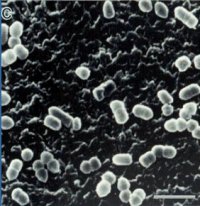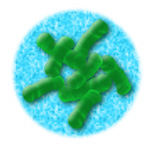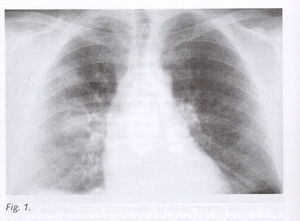Prevotella: Difference between revisions
No edit summary |
No edit summary |
||
| Line 1: | Line 1: | ||
{{Biorealm}} | {{Biorealm Genus}} | ||
[[Image:p_ruminicola.jpg|thumb|400px|right|''Prevotella ruminicola.''Image Courtesy of [http://www.tigr.org/tdb/rumenomics/genomes.shtml TIGR.]]] | [[Image:p_ruminicola.jpg|thumb|400px|right|''Prevotella ruminicola.''Image Courtesy of [http://www.tigr.org/tdb/rumenomics/genomes.shtml TIGR.]]] | ||
| Line 18: | Line 12: | ||
''P. albensis; P. baroniae; P. bergensis; P. bivia; P. brevis; P. bryantii; P. buccae; P. buccalis; P. corporis; P. dentalis; P. denticola; P. disiens; P. enoeca; P. genomosp. C1; P. intermedia; P. loescheii; P. marshii; P. melaninogenica; P. multiformis; P. multisaccharivorax; P. nigrescens; P. oralis; P. oris; P.oulorum; P. pallens; P. ruminicola; P.ruminicola 23; P. aff. ruminicola Tc2-24; P. salivae; P. shahii; P. tannerae; P. veroralis; P. sp.'' | ''P. albensis; P. baroniae; P. bergensis; P. bivia; P. brevis; P. bryantii; P. buccae; P. buccalis; P. corporis; P. dentalis; P. denticola; P. disiens; P. enoeca; P. genomosp. C1; P. intermedia; P. loescheii; P. marshii; P. melaninogenica; P. multiformis; P. multisaccharivorax; P. nigrescens; P. oralis; P. oris; P.oulorum; P. pallens; P. ruminicola; P.ruminicola 23; P. aff. ruminicola Tc2-24; P. salivae; P. shahii; P. tannerae; P. veroralis; P. sp.'' | ||
{| | |||
| height="10" bgcolor="#FFDF95" | | |||
'''NCBI: '''[http://www.ncbi.nlm.nih.gov/Taxonomy/Browser/wwwtax.cgi?mode=Info&id=838&lvl=3&lin=f&keep=1&srchmode=1&unlock '''Taxonomy''']''' Genome: '''[http://www.ncbi.nlm.nih.gov/entrez/query.fcgi?db=genomeprj&cmd=Retrieve&dopt=Overview&list_uids=175 ''P. intermedia 17''] ''[http://www.ncbi.nlm.nih.gov/entrez/query.fcgi?db=genomeprj&cmd=Retrieve&dopt=Overview&list_uids=10619 P. ruminicola 23]'' | |||
|} | |||
==Description and Significance== | ==Description and Significance== | ||
Revision as of 14:48, 16 August 2006
A Microbial Biorealm page on the genus Prevotella

Classification
Higher order taxa:
Bacteria; Bacteroidetes/Chlorobi group; Bacteroidetes; Bacteroidetes (class); Bacteroidales; Prevotellaceae
Species:
P. albensis; P. baroniae; P. bergensis; P. bivia; P. brevis; P. bryantii; P. buccae; P. buccalis; P. corporis; P. dentalis; P. denticola; P. disiens; P. enoeca; P. genomosp. C1; P. intermedia; P. loescheii; P. marshii; P. melaninogenica; P. multiformis; P. multisaccharivorax; P. nigrescens; P. oralis; P. oris; P.oulorum; P. pallens; P. ruminicola; P.ruminicola 23; P. aff. ruminicola Tc2-24; P. salivae; P. shahii; P. tannerae; P. veroralis; P. sp.
|
NCBI: Taxonomy Genome: P. intermedia 17 P. ruminicola 23 |
Description and Significance
Prevotella sp. are among the most numerous microbes culturable from the rumen and hind gut of cattle and sheep, where they help the breakdown of protein and carbohydrate foods. They are also present in humans, where they can be opportunistic pathogens. Prevotella, credited interchangably with Bacteroides melaninogenicus, has been a problem for dentists for years. As a human pathogen known for creating periodontal and tooth problems, Prevotella has long been studied in order to counteract its pathogenesis (AAP).
Genome Structure
Two strains of Prevotella have been completely sequenced: Prevotella intermedia 17 and Prevotella ruminicola 23. Both strains were sequenced by TIGR. The sequencing of these two genomes has lead to increased ability to combat Prevotella strains' pathogenic abilities.
Cell Structure and Metabolism

Prevotella strains are Gram-negative, non-motile, rod-shaped, singular cells that thrive in anaerobic growth conditions. They are known for being host-associated, colonizing the human mouth. Prevotella bacteria colonize by binding or attaching to other bacteria in addition to epithelial cells, creating a larger infection in previously infected areas. Another survival mechanism is Prevotella cells' natural antibiotic resistant genes, which prevent extermination (TIGR).
Pathology
About twenty identified species of Prevotella are known to cause infection, including Prevotella dentalis, which was previously known as Mitsuokella dentalis. Prevotella species cause infections such as abscesses, bacteraemia, wound infection, bite infections, genital tract infections, and periodontitis (Pavillion). Specific infections caused by Prevotella include the disease of tissues surrounding an individuals teeth (see photo at right) and of the supporting tooth and gingivitis (TIGR). Symptoms of Prevotella infections can include pain, swelling, and in some cases a "wet" canal (Gomes).

Antibiotics for treating Prevotella include metronidazole, amoxycillin/clavulanate, ureidopenicilins, carbapenems, cephalosporins, clindamycin, and chloramphenicol (Pavillion).
Prevotella is also well-known as a preventative agent for the bovine disease of rumen acidosis. Rumen acidosis greatly affects milk production of cattle by disrupting the typical digestive processes of the stomach. This leads to an increased susceptibility to other pathogenic forces which also affect the health of food provided from the cattle. With an estimated twenty percent of all American cattle suffering from some form of acidosis, it has been calculated that the bovine market loses one billion dollars annually (ARS).
References
AAP. American Academy of Prediatrics. Red Book Online. "Bacteroides and Prevotella Infections."
Pavillion. 2000. Guide To Bacteria Associated with Infections In Humans. "Prevotella."
TIGR. The Institute for Genomic Research. "Prevotella intermedia 17."
